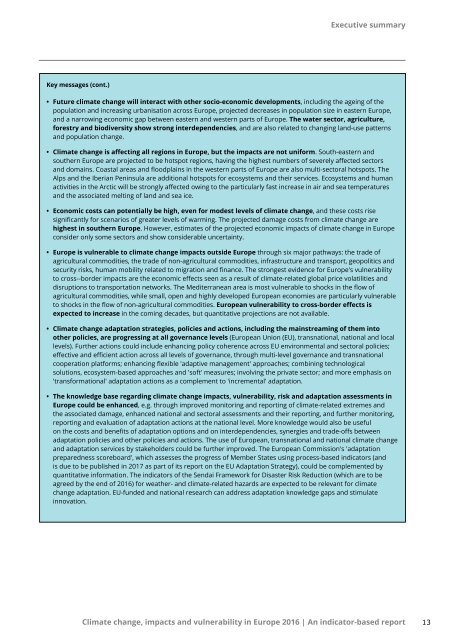Climate change impacts and vulnerability in Europe 2016
document
document
You also want an ePaper? Increase the reach of your titles
YUMPU automatically turns print PDFs into web optimized ePapers that Google loves.
Executive summary<br />
Key messages (cont.)<br />
• Future climate <strong>change</strong> will <strong>in</strong>teract with other socio-economic developments, <strong>in</strong>clud<strong>in</strong>g the age<strong>in</strong>g of the<br />
population <strong>and</strong> <strong>in</strong>creas<strong>in</strong>g urbanisation across <strong>Europe</strong>, projected decreases <strong>in</strong> population size <strong>in</strong> eastern <strong>Europe</strong>,<br />
<strong>and</strong> a narrow<strong>in</strong>g economic gap between eastern <strong>and</strong> western parts of <strong>Europe</strong>. The water sector, agriculture,<br />
forestry <strong>and</strong> biodiversity show strong <strong>in</strong>terdependencies, <strong>and</strong> are also related to chang<strong>in</strong>g l<strong>and</strong>-use patterns<br />
<strong>and</strong> population <strong>change</strong>.<br />
• <strong>Climate</strong> <strong>change</strong> is affect<strong>in</strong>g all regions <strong>in</strong> <strong>Europe</strong>, but the <strong>impacts</strong> are not uniform. South-eastern <strong>and</strong><br />
southern <strong>Europe</strong> are projected to be hotspot regions, hav<strong>in</strong>g the highest numbers of severely affected sectors<br />
<strong>and</strong> doma<strong>in</strong>s. Coastal areas <strong>and</strong> floodpla<strong>in</strong>s <strong>in</strong> the western parts of <strong>Europe</strong> are also multi-sectoral hotspots. The<br />
Alps <strong>and</strong> the Iberian Pen<strong>in</strong>sula are additional hotspots for ecosystems <strong>and</strong> their services. Ecosystems <strong>and</strong> human<br />
activities <strong>in</strong> the Arctic will be strongly affected ow<strong>in</strong>g to the particularly fast <strong>in</strong>crease <strong>in</strong> air <strong>and</strong> sea temperatures<br />
<strong>and</strong> the associated melt<strong>in</strong>g of l<strong>and</strong> <strong>and</strong> sea ice.<br />
• Economic costs can potentially be high, even for modest levels of climate <strong>change</strong>, <strong>and</strong> these costs rise<br />
significantly for scenarios of greater levels of warm<strong>in</strong>g. The projected damage costs from climate <strong>change</strong> are<br />
highest <strong>in</strong> southern <strong>Europe</strong>. However, estimates of the projected economic <strong>impacts</strong> of climate <strong>change</strong> <strong>in</strong> <strong>Europe</strong><br />
consider only some sectors <strong>and</strong> show considerable uncerta<strong>in</strong>ty.<br />
• <strong>Europe</strong> is vulnerable to climate <strong>change</strong> <strong>impacts</strong> outside <strong>Europe</strong> through six major pathways: the trade of<br />
agricultural commodities, the trade of non-agricultural commodities, <strong>in</strong>frastructure <strong>and</strong> transport, geopolitics <strong>and</strong><br />
security risks, human mobility related to migration <strong>and</strong> f<strong>in</strong>ance. The strongest evidence for <strong>Europe</strong>'s <strong>vulnerability</strong><br />
to cross‐-border <strong>impacts</strong> are the economic effects seen as a result of climate-related global price volatilities <strong>and</strong><br />
disruptions to transportation networks. The Mediterranean area is most vulnerable to shocks <strong>in</strong> the flow of<br />
agricultural commodities, while small, open <strong>and</strong> highly developed <strong>Europe</strong>an economies are particularly vulnerable<br />
to shocks <strong>in</strong> the flow of non-agricultural commodities. <strong>Europe</strong>an <strong>vulnerability</strong> to cross-border effects is<br />
expected to <strong>in</strong>crease <strong>in</strong> the com<strong>in</strong>g decades, but quantitative projections are not available.<br />
• <strong>Climate</strong> <strong>change</strong> adaptation strategies, policies <strong>and</strong> actions, <strong>in</strong>clud<strong>in</strong>g the ma<strong>in</strong>stream<strong>in</strong>g of them <strong>in</strong>to<br />
other policies, are progress<strong>in</strong>g at all governance levels (<strong>Europe</strong>an Union (EU), transnational, national <strong>and</strong> local<br />
levels). Further actions could <strong>in</strong>clude enhanc<strong>in</strong>g policy coherence across EU environmental <strong>and</strong> sectoral policies;<br />
effective <strong>and</strong> efficient action across all levels of governance, through multi-level governance <strong>and</strong> transnational<br />
cooperation platforms; enhanc<strong>in</strong>g flexible 'adaptive management' approaches; comb<strong>in</strong><strong>in</strong>g technological<br />
solutions, ecosystem-based approaches <strong>and</strong> 'soft' measures; <strong>in</strong>volv<strong>in</strong>g the private sector; <strong>and</strong> more emphasis on<br />
'transformational' adaptation actions as a complement to '<strong>in</strong>cremental' adaptation.<br />
• The knowledge base regard<strong>in</strong>g climate <strong>change</strong> <strong>impacts</strong>, <strong>vulnerability</strong>, risk <strong>and</strong> adaptation assessments <strong>in</strong><br />
<strong>Europe</strong> could be enhanced, e.g. through improved monitor<strong>in</strong>g <strong>and</strong> report<strong>in</strong>g of climate-related extremes <strong>and</strong><br />
the associated damage, enhanced national <strong>and</strong> sectoral assessments <strong>and</strong> their report<strong>in</strong>g, <strong>and</strong> further monitor<strong>in</strong>g,<br />
report<strong>in</strong>g <strong>and</strong> evaluation of adaptation actions at the national level. More knowledge would also be useful<br />
on the costs <strong>and</strong> benefits of adaptation options <strong>and</strong> on <strong>in</strong>terdependencies, synergies <strong>and</strong> trade-offs between<br />
adaptation policies <strong>and</strong> other policies <strong>and</strong> actions. The use of <strong>Europe</strong>an, transnational <strong>and</strong> national climate <strong>change</strong><br />
<strong>and</strong> adaptation services by stakeholders could be further improved. The <strong>Europe</strong>an Commission's 'adaptation<br />
preparedness scoreboard', which assesses the progress of Member States us<strong>in</strong>g process-based <strong>in</strong>dicators (<strong>and</strong><br />
is due to be published <strong>in</strong> 2017 as part of its report on the EU Adaptation Strategy), could be complemented by<br />
quantitative <strong>in</strong>formation. The <strong>in</strong>dicators of the Sendai Framework for Disaster Risk Reduction (which are to be<br />
agreed by the end of <strong>2016</strong>) for weather- <strong>and</strong> climate-related hazards are expected to be relevant for climate<br />
<strong>change</strong> adaptation. EU-funded <strong>and</strong> national research can address adaptation knowledge gaps <strong>and</strong> stimulate<br />
<strong>in</strong>novation.<br />
<strong>Climate</strong> <strong>change</strong>, <strong>impacts</strong> <strong>and</strong> <strong>vulnerability</strong> <strong>in</strong> <strong>Europe</strong> <strong>2016</strong> | An <strong>in</strong>dicator-based report<br />
13


